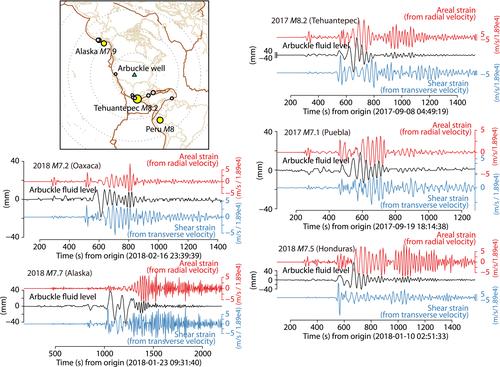Teleseismic waves reveal anisotropic poroelastic response of wastewater disposal reservoir
IF 1.9
3区 地球科学
引用次数: 2
Abstract
Connecting earthquake nucleation in basement rock to fluid injection in basal, sedimentary reservoirs, depends heavily on choices related to the poroelastic properties of the fluid‐rock system, thermo‐chemical effects notwithstanding. Direct constraints on these parameters outside of laboratory settings are rare, and it is commonly assumed that the rock layers are isotropic. With the Arbuckle wastewater disposal reservoir in Osage County, Oklahoma, high‐frequency formation pressure changes and collocated broadband ground velocities measured during the passing of large teleseismic waves show a poroelastic response of the reservoir that is both azimuthally variable and anisotropic; this includes evidence of static shifts in pressure that presumably relate to changes in local permeability. The azimuthal dependence in both the static response and shear coupling appears related to tectonic stress and strain indicators such as the orientations of the maximum horizontal stress and faults and fractures. Using dynamic strains from a nearby borehole strainmeter, we show that the ratio of shear to volumetric strain coupling is ~0.41 which implies a mean Skempton's coefficient ofA = 0.24 over the plausible range of the undrained Poisson's ratio. Since these observations are made at relatively low confining pressure and differential stress, we suggest that the hydraulically conductive fracture network is a primary control on the coupling between pore pressure diffusion and elastic stresses in response to natural or anthropogenic sources.

远震波揭示了污水处理储层的各向异性孔隙弹性响应
将基底岩石中的地震成核与基底沉积储层中的流体注入联系起来,在很大程度上取决于与流体-岩石系统的孔隙弹性特性相关的选择,尽管存在热化学效应。在实验室环境之外,对这些参数的直接限制很少,通常假设岩层是各向同性的。在俄克拉何马州奥塞奇县的Arbuckle废水处理油藏中,在大远地震波传递过程中测量的高频地层压力变化和同时分布的宽带地面速度显示了储层的孔隙弹性响应,该储层具有方位角变量和各向异性;这包括压力静态变化的证据,这可能与局部渗透率的变化有关。静态响应和剪切耦合的方位角依赖性与构造应力和应变指标(如最大水平应力方向和断层和裂缝方向)有关。利用附近钻孔应变计的动态应变,我们发现剪切与体积应变耦合的比值为~0.41,这意味着在不排水泊松比的合理范围内,平均Skempton系数a = 0.24。由于这些观察结果是在相对较低的围压和差应力下进行的,因此我们认为,在自然或人为源的作用下,水力导流裂缝网络是孔隙压力扩散和弹性应力耦合的主要控制因素。
本文章由计算机程序翻译,如有差异,请以英文原文为准。
求助全文
约1分钟内获得全文
求助全文

 求助内容:
求助内容: 应助结果提醒方式:
应助结果提醒方式:


